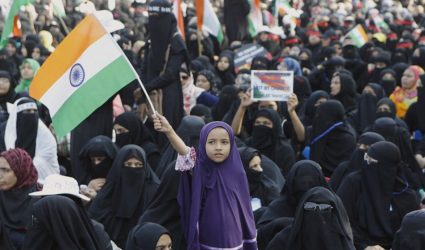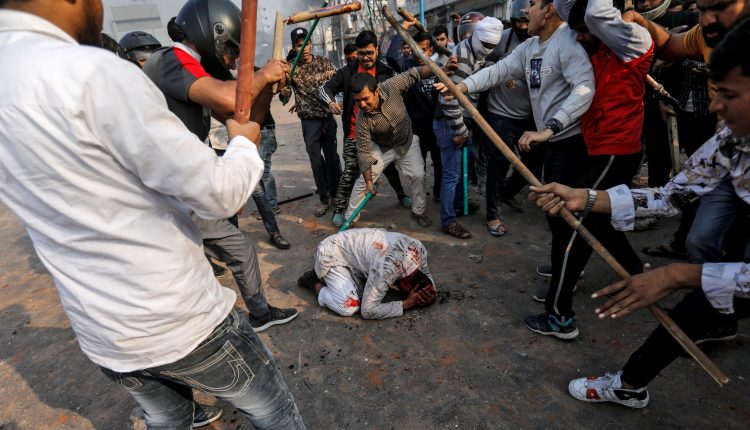Delhi clashes: 21 killed as Hindu and Muslim groups clash

(BBC) – Delhi remains on edge after the third consecutive night of rioting, with reports of Muslim homes and shops being targeted by violent mobs.
Twenty-one people have been killed so far in the deadliest violence the Indian capital has seen in decades.
The clashes first broke out on Sunday between protesters for and against a controversial citizenship law.
But they have since taken on communal overtones, with reports of people being attacked based on their religion.
Photographs, videos and accounts on social media paint a chilling image of the last few days – of mobs beating unarmed men, including journalists; of groups of men with sticks, iron rods and stones wandering the streets; and of Hindus and Muslims facing off.
Prime Minister Narendra Modi tweeted on Wednesday, three days after the violence broke out, appealing for peace. He added that he had reviewed the situation and police were working to restore normalcy.
Delhi Chief Minister Arvind Kejriwal has described the situation as “alarming” and demanded for the army to be called in.
The unrest is centred around Muslim-majority neighbourhoods – such as Maujpur, Mustafabad, Jaffrabad and Shiv Vihar – in north-east Delhi.
The streets in these areas are littered with stones and shattered glass, broken and burnt vehicles are strewn about, and the stench of smoke from smouldering buildings fills the air.

What is happening now?
While fresh clashes have not been reported on Wednesday, the city continues to simmer.
Judging by the names released so far, both Hindus and Muslims are among victims. Some 189 people are injured, according to officials at the Guru Teg Bahadur hospital where many of them have been admitted.
BBC reporters at the hospital say they saw people with all sorts of injuries, including bullet wounds, scrambling for treatment. They say the hospital seemed “overwhelmed”, and many of the injured were “too scared to go back home”.
Many, including journalists, have tweeted and spoken of mobs demanding to know their religion. At least one photojournalist said he was asked to remove his pants to prove his identity. This has also happened during religious riots in the past to identify Muslims as they are usually circumcised.
Why did it turn deadly so quickly?
It appears to have started with a threat issued by Kapil Mishra, a leader from the governing Bharatiya Janata Party (BJP), against protesters opposing the citizenship law.
On Sunday, he led a rally in Jaffrabad – and asked people via Twitter – to gather in the area. In his tweet, he told the Delhi police they had three days to clear the protest sites and warned of consequences if they failed to do so.
The first reports of clashes emerged later that day.
The Citizenship Amendment Act (CAA), which grants amnesty to illegal non-Muslim immigrants from certain Muslim-majority countries, has sharply polarised India.
Critics say it discriminates against Muslims, while the government denies this, saying it only offers citizenship to persecuted minorities.
But it has sparked huge protests, including those led by Muslim women. Some of these protests – such as the one in Delhi’s Shaheen Bagh – have become the target of right-wing vitriol.
What are authorities doing?
“There are enough forces on the ground and no one needs to fear,” National Security Advisor Ajit Doval told NDTV news channel, and asked the people of Delhi to trust “the man in uniform”.
Mr Doval was responding to reports that police were allegedly not doing enough to help those under attack.
The affected areas are close to the Loni border – that Delhi shares with Uttar Pradesh state – which has now been sealed. Schools in the area have been closed, and year-end exams postponed.
The Delhi police have also been accused of being under-prepared and outnumbered. More than 50 policemen have also been injured and at least one – a constable named Ratan Lal – was killed.
Police spokesman MS Randhawa told reporters on Tuesday that the situation was under control and a “sufficient number of policemen” had been deployed. Paramilitary forces have been deployed as well.
The central cabinet is expected to meet later on Wednesday to review the situation. Home Minister Amit Shah, who is in-charge of the city’s police force, led a meeting with officials and policemen on Tuesday night.
The timing of the unrest is being seen as an embarrassment for Prime Minister Narendra Modi as he was hosting US President Donald Trump over the last two days on his first official visit to India.
As the violence escalated, it overshadowed Mr Trump’s visit, making it to national and global headlines.

